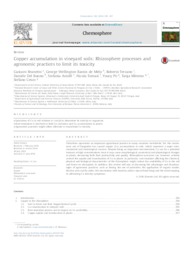Copper accumulation in vineyard soils: Rhizosphere processes and agronomic practices to limit its toxicity.
Copper accumulation in vineyard soils: Rhizosphere processes and agronomic practices to limit its toxicity.
Autoria: BRUNETTO, G.; MELO, G. W. B. de; TERZANO, R.; DEL BUONO, D.; ASTOLFI, S.; TOMASI, N.; PII, Y.; MIMMO, T.; CESCO, S.
Resumo: Viticulture represents an important agricultural practice in many countries worldwide. Yet, the continuous use of fungicides has caused copper (Cu) accumulation in soils, which represent a major environmental and toxicological concern. Despite being an important micronutrient, Cu can be a potential toxicant at high concentrations since it may cause morphological, anatomical and physiological changes in plants, decreasing both food productivity and quality. Rhizosphere processes can, however, actively control the uptake and translocation of Cu in plants. In particular, root exudates affecting the chemical, physical and biological characteristics of the rhizosphere, might reduce the availability of Cu in the soil and hence its absorption. In addition, this review will aim at discussing the advantages and disadvantages of agronomic practices, such as liming, the use of pesticides, the application of organic matter, biochar and coal fly ashes, the inoculation with bacteria and/or mycorrhizal fungi and the intercropping, in alleviating Cu toxicity symptoms.
Ano de publicação: 2016
Tipo de publicação: Artigo de periódico
Unidade: Embrapa Uva e Vinho
Palavras-chave: Cobre, Copper, Cu toxicidade, Cu toxicity, Processos da rizosfera, Rhizosphere processes, Solos de vinhedos, Vineyard soils
Observações
1 - Por padrão são exibidas publicações dos últimos 20 anos. Para encontrar publicações mais antigas, configure o filtro ano de publicação, colocando o ano a partir do qual você deseja encontrar publicações. O filtro está na coluna da esquerda na busca acima.
2 - Para ler algumas publicações da Embrapa (apenas as que estão em formato ePub), é necessário ter, no celular ou computador, um desses softwares gratuitos. Sistemas Android: Google Play Livros; IOS: iBooks; Windows e Linux: software Calibre.
Acesse outras publicações
Acesse a Base de Dados da Pesquisa Agropecuária (BDPA) para consultar o acervo completo das bibliotecas da Embrapa.

